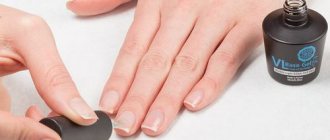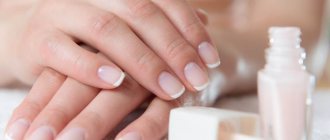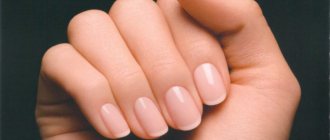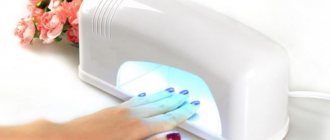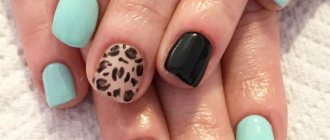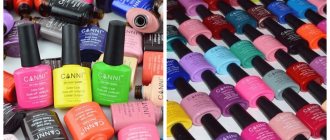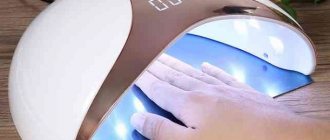Most people who like to show off a beautiful and long-lasting manicure often complain that regular polish takes a long time to dry, quickly chips, leaves “bald spots” on the nails, and leads to nail splitting. But acrylic or gel is not suitable for all nails. It is for these lovely ladies that shellac was created - the only hybrid of gel and varnish in the world. But here another important question arises: is it possible to apply regular varnish to shellac? To do this, let's get acquainted with the properties of this miracle varnish - shellac.
Why is gel polish dangerous for nails?
There are many myths about the dangerous effect of shellac on nails that scare girls away, forcing them to continue using other types of manicure. Whether persistent application is so harmful will be discussed below.
How does gel polish affect nails?
Gel polish coatings firmly adhere to the surface of the nail plates, the design stays on them for a long time, firmly, and does not chip or crack. Due to the ability of strong adhesion to the surface, varnishes have gained wide popularity.
It turns out that the coating applied to properly prepared nails in accordance with the technology does not cause any harm to the plates; on the contrary, it decorates them for a long time. But the matter does not end with following the stages of preparation for a manicure and its actual implementation - the gel polish must be removed correctly. If the coating is removed incorrectly, there is a high risk of damage to the plate. It is not the gel polish coating that has a negative effect on the nails, but a special remover, the use of metal sticks to remove varnish residues, and manually pulling off a cracked piece of coating along with the surface of the plate.
There are concerns that multi-layer application has a negative impact on the condition of natural plates. Indeed, the coating is considered quite thick - it is applied in 3-5 layers (base, color, top), but this does not affect the availability of the necessary power to the plates. Nails do not need air access; they do not have pores. The keratinized areas of the skin receive the necessary nutrition from the growth zone, which remains unpainted.
Harmful substances in nail polish
The high-quality composition of the gel polish allows you to create a long-lasting, safe, harmless manicure that can be worn without resting your nails for several weeks.
Each varnish contains:
- photoinitiator - helps the coating become hard under the influence of the lamp;
- diluent;
- film former – creates another film on the application surface;
- color pigment;
- additional components.
High-quality gel polish is considered absolutely safe. Another thing is cheap substitutes containing toxic additives - additional components. Before starting a manicure, it is important to familiarize yourself with the composition of the cosmetic product. The following components should be on your guard:
- Formaldehyde is a preservative that extends the shelf life of varnish and is characterized by its ability to be absorbed through the nail tissue into the blood and accumulate in the body. The substance causes allergies and damages the nail plate.
- Toluene, a substance that ensures smooth application of varnish, provokes problems with the nervous system, nausea, and poisoning.
- Dibutyl phthalate is a substance that protects the coating from chipping and has a negative effect on skin cells and lungs.
Less dangerous, but also not welcome in varnish, are xylene, camphor, and methaclyric acid. Wearing a manicure done with a low-quality product without rest will only make the situation worse.
Important! Particular attention to the composition of the varnish should be paid to pregnant and lactating women, because some harmful components can penetrate into the baby’s body and milk.
Is a lamp for drying gel polish harmful?
There is an opinion that the UV lamp used in the polymerization of gel nail polish can be harmful, causing cancer. The information has not been confirmed by scientific researchers, so it cannot be considered true. It has been proven that continuously holding your hands in a lamp is equivalent to 10 minutes spent in the sun. For those who are still concerned about the harmful effects of the device, it is recommended to apply a layer of sunscreen to the skin.
We are talking about lamps in which the lighting elements are changed in a timely manner. They have a certain shelf life - the number of hours during which the lamp can operate. If it contains an expired element that has long worked for the allotted number of hours, the lamp may emit harmful substances.
Recommendations for applying shellac
If we take into account the above characteristics of shellac, its application requires special consistency and adherence to certain rules. First you need to do a dry manicure: carefully trim the cuticle and give the desired shape to the nail plate. Natural gloss can be removed using a buff or nail file. Once you have removed the dust particles, your nails must be additionally treated with a special degreasing compound. Only if these procedures have been completed can a base coat of shellac be applied. It must be dried under the rays of an ultraviolet lamp for two minutes, and only then apply a colored layer. After drying, apply the last layer of finishing varnish, which will evenly cover the entire surface of the nail.
Using a degreasing liquid, it is necessary to remove the top sticky layer of varnish. As for applying shellac to regular varnish, numerous experiments have shown that the result of such a coating is similar to applying shellac to a greasy surface. This happens because the oils contained in regular varnish are incompatible with shellac resins. However, shellac works great on gel or acrylic nails.
As for applying regular varnish to shellac, there are several nuances. Firstly, regular varnish contains toxic substances that are also incompatible with the natural components of shellac. And, secondly, these products have different textures. Shellac has a porous texture, which allows the nail plate to breathe and maintain a healthy appearance. Conventional varnish covers the nail plate with a dense, continuous layer, and therefore completely blocks the access of air. Likewise, regular polish will clog shellac, which can lead to cracks and chips within the first few days of application.
However, this rule also has an exception. Regular varnish can be applied to shellac as decorative elements. A small amount of regular varnish applied to the shellac before the topcoat will not spoil the beauty of the manicure. Of course, it is necessary to take into account the composition and brand of both products. Applying regular varnish follows the principle of adding sparkles or rhinestones to shellac. Decorative elements are added to the sticky surface of the second layer of shellac, then everything must be covered with a finishing layer and dried.
Do you need to rest your nails from gel polish?
Experts say that a break from wearing a covering is simply necessary. After several manicure sessions, you should pay attention to restoring the plates and devote time to caring for them. This is the rest of the plates.
Is it harmful to do shellac all the time?
Many sources talk about the dangers of constantly wearing shellac on nails, claiming that the coating dries out, thins the plates, and fungal diseases can form in microcracks under the coating. These factors arise as a result of improper application of the coating, preparation for it, and directly depend on the skill level of the master.
If, after removing the coating, your natural nails look bad or painful, you need to give them a rest: replace the gel polish with a medicinal polish that helps restore the structure of your nails and give them a healthy look. During relaxation, massages with nourishing creams and oils, restorative baths, masks and other procedures aimed at improving the health of natural nails will be useful.
Important! On weak, brittle nails, the shellac coating does not last long and quickly becomes unsightly, so if problems arise with the health of the nail plates, you will have to give them a rest.
How long can you wear gel polish without a break?
Theoretically, gel polish coating can be worn constantly, without rest, but after a few weeks the nails will look unaesthetic. Natural plates grow; as the artificial coating grows, it moves from the cuticle to the center of the plate. As a result, you have to remove the application and do the manicure again.
The main product that harms natural nails is gel polish remover, the composition of which has an extremely aggressive effect on the nail - it dries and thins. After each gel polish removal procedure, you need to give your nails a short rest: moisten the surface with a rich cream.
Important! To avoid dehydration of the nail plate, the skin of the fingers and cuticles are regularly lubricated with a nourishing cream even when the coating is applied, not only during the rest period.
When changing the gel polish design, it is recommended to take a rest for your nails. It is advisable to give it a rest at least once every 2 months if there are no problems with the health of the nails.
Opinion of a professional master about the need for nails to rest:
The main advantages of gel polish
Before using any type of coating for nail plates, you must carefully study the composition of the product. Pay attention to safety indicators to protect the health and beauty of your nails. It is necessary to evaluate the degree of ease of use, time of preservation of the original appearance and texture.
Gel polish is a product that combines the maximum characteristics that meet the requirements of the most attentive beauties:
- the use of natural resin components minimizes the risk of harm to the nail plate;
- Due to the lower concentration of polymer compounds, the aggressive effect of gel polishes on nails is significantly lower than that of other popular coatings (acrylic, gel). Naturally, it is worth observing the application technology and time of use of the product. There is no need to go beyond the designated period;
- there is no need to file the nail plate, which is present in other techniques. For example, nails extended with acrylic, biogel;
- The gel polish coating is very light, which makes it almost invisible during operation;
- does not require routine special care;
- an important high indicator of resistance to contact with water, fruit acids, etc. When using cleaning chemicals, you should wear rubber gloves, which will not only preserve the coating of your nails, but also protect the skin of your hands from possible burns;
- You can apply gel polish yourself at home. This is a simple process that takes a little time. A prerequisite is to strictly follow and follow the instructions on the layer application technique. The same applies to the withdrawal procedure;
- a variety of colors will allow you to realize the most daring author's ideas;
- long-term integrity of the coating and preservation of shine throughout the entire wear period;
- applying gel polish includes the stage of “sealing” the nail, which will eliminate delamination of the nail plate and gradually increase its length;
- the absence of a pronounced unpleasant odor plays an important role in the process of use.
How to minimize the harm of gel nail polish
There are a number of measures to reduce the harmful effects of the coating and avoid the consequences that arise from an unsuccessful shellac manicure.
- Before a shellac manicure, it is recommended to saturate the plates with calcium by regularly applying special medicinal products.
- If the plates look unhealthy, before deciding on shellac, you need to undergo a restorative course: rubbing in olive oil, strengthening with baths, masks, drinking a vitamin complex.
- Cuticle care is required - massage, moisturizing with creams and oils.
These manipulations will help neutralize the harmful effects of varnish on nails.
Is it possible to remove gel nail polish at home?
Nails coated with gel polish do not require any specific care or maintenance rules. However, getting rid of an “overgrown” manicure is more difficult than getting rid of regular polish. You need to purchase gel polish remover (Shellac) from a specialized cosmetic store.
Removing gel polish from nails at home
So, they need to moisten cut cotton pads (Fig. 2), apply them to the nail plate and wrap each nail with foil so that the product does not evaporate (Fig. 3). After waiting about 20 minutes, remove the foil and cotton pads, the gel will come off with them (Fig. 4), its remnants can be removed using an orange stick and filing with a sanding file (Fig. 5).
You can read more about removing gel polish, including using a device, in the article: Methods for removing gel polish at home
Using gel polish for manicure is the most reasonable solution. In order for it to please you for a long time, you need to use rubber gloves during prolonged contact with water and household chemicals.
Contraindications to shellac
The application has a number of contraindications; people who have at least one of the above problems should refuse manicure:
- weakened, brittle, peeling nail plates;
- nail diseases (fungal and non-fungal);
- allergies, individual intolerance to one of the components of the nail polish or nail polish remover;
- thin sensitive cuticle;
- skin diseases (eczema, psoriasis, etc.);
- medical nail extension;
- white spots on the plates, indicating a lack of vitamins and body malfunctions;
- immediately after treatment of fungal diseases, the infection may reappear
Other groups of people can get a manicure without fear, sometimes giving their nails a break from constantly wearing the coating.
Consequences of gel polish
As a result of prolonged wear of such a manicure, incorrect execution technology, or the use of low-quality composition, the coating can cause unpleasant consequences that affect the health and appearance of natural plates. These include:
- change in the natural color of the nail - yellowing, dullness;
- thinning of the plate, causing fragility, brittleness, cracking;
- the surface becomes uneven, bumpy;
- change in structure - delamination.
Proper use of gel polish with optimal rest usually occurs without harm to the nails and does not cause the above-mentioned consequences.
Reviews: is gel nail polish harmful?
On the Internet you can find many reviews about the dangers and benefits of gel polish, and the need for plates to take a break from it. They are left by girls who have tried manicure at least once.
Maslennikova Irina Aleksandrovna, 40 years old, Astrakhan
The shellac coating was done in a professional salon, and within a week chips appeared on it. I decided not to go to the salon where they provided poor quality services, but to rent at home myself. I bought a special liquid, soaked cotton pads in it, wrapped it around my fingers, and secured it with foil. When I removed these tricks, it turned out that the coating had not completely come off; I had to scrape off the remains manually. The result after removal was terrifying - the plates were so destroyed that it took six months to restore them.
Nikiforova Olga Dmitrievna, 36 years old, Staavropol
I really wanted to try gel polish, but I was scared by the reviews about the dangers of the UV lamp. I have moles on my hands, so there is cause for concern. As a result, I didn’t take any risks and turned to a specialist who had an LED lamp at his disposal. Now I constantly get manicures from him without fear, after every 2 sessions I give my nails a rest: I cover them with medicinal varnish, do oil baths, which turn caring for the plates into a real pleasure and a pleasant pastime.
What is gel polish coating in manicure?
The procedure for performing a manicure using gel polish is offered in almost every beauty salon. There are also a huge number of manicurists working at home. Recently, many girls began to buy all the necessary equipment to perform a manicure using a gel coating and, accordingly, do it at home. But nevertheless, when all the necessary materials have already been purchased, the question arises: “How to do a manicure?” We will answer this question by talking in detail about the technology for properly applying gel polish at home. Before you start creating a manicure, you need to understand what coating your nails with gel polish (shellac) is. The gel polish itself is a porous polymer that allows air to pass through. It has a number of advantages:
- Lasts up to 4 weeks, which saves time on manicure, because even the best varnish does not last more than 5 days.
- Does not require any special skills, application is quite simple.
- Variety of color options. Every girl can choose a gel according to her mood.
- Gel polish perfectly levels the surface of the nail plate.
- Does not spoil the structure of the nail itself.
However, this manicure also has its drawbacks, which generally do not spoil the overall picture of its advantages. For example:
- The procedure is expensive, especially if you get a manicure in a salon from a good specialist. Applying gel polish yourself at home also requires expenses for tools and materials (UV lamp, special acetone-containing liquids, etc.)
- Wearing a manicure using shellac for a long time is harmful. Therefore, after 4-5 times of application, nails must be given time to rest and recover.
- Difficulty in removing gel polish. Regular nail polish remover will not work for this. It is necessary to use only acetone-containing liquids and spend a sufficient amount of time on the procedure for removing the gel.
